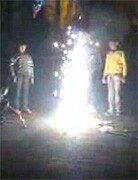- Skip Storing This Everyday Product in the Fridge Door
- Green Tea + B3 Pairing May Boost Brain Health
- Navigating Your Midlife Crisis: Embracing New Possibilities
- City Raccoons Showing Signs of Domestication
- Mapping the Exposome: Science Broadens Focus to Environmental Disease Triggers
- One Week Less on Social Media Linked to Better Mental Health
- Your Brain Changes in Stages as You Age, Study Finds
- Some Suicide Victims Show No Typical Warning Signs, Study Finds
- ByHeart Formula Faces Lawsuits After Babies Sickened With Botulism
- Switch to Vegan Diet Could Cut Your Greenhouse Gas Emissions in Half
Fireworks Can Spark Bump in Air Pollution, Study Finds


Most Americans know that fireworks can injure the eyes and hands, but these Fourth of July favorites can also take a toll on the lungs, a new study finds.
Researchers from the National Oceanic and Atmospheric Administration (NOAA) found fireworks produce air pollutants, including tiny particles found in the air known as particulate matter.
These microscopic particles of dust, dirt, soot, smoke and liquids can get inside the lungs and cause coughing, wheezing and shortness of breath. They can also lead to long-term health issues, such as asthma attacks, heart attack, stroke and even death in those with heart or lung disease.
Using observations from 315 U.S. air quality-monitoring sites recorded from 1999 to 2013, the NOAA researchers quantified the surge in particulate matter that occurred on the nation’s birthday. Specifically, they looked for particles that are two and one half microns in diameter (PM2.5).
Hourly concentrations of fine particulate matter typically reach their highest levels in the evening on July 4, the study revealed. On average, the sharpest increase occurred between 9 and 10 p.m. The levels subside by noon on July 5. Starting at 8 p.m. on July 4, average concentrations in particulate matter for the next 24 hours are 42 percent greater than the days before or after the holiday, the study published June 30 in the journal Atmospheric Environment revealed.
“We chose the holiday, not to put a damper on celebrations of America’s independence, but because it is the best way to do a nationwide study of the effects of fireworks on air quality,” study co-author Dian Seidel, a senior scientist at NOAA’s Air Resources Laboratory in College Park, Md., said in an agency news release.
“These results will help improve air quality predictions, which currently don’t account for fireworks as a source of air pollution,” Seidel added. “The study is also another wake-up call for those who may be particularly sensitive to the effects of fine particulate matter.”
The researchers found that the concentrations of fine particulate matter varied among the locations tested, with proximity to fireworks displays and weather conditions playing a role in these differences.
Although the U.S. Environmental Protection Agency does not regulate fireworks, the agency does advise people who are sensitive to particle pollution to limit their exposure.
These high-risk groups should watch fireworks from a position upwind or from a distance. People with asthma should follow their asthma action plans and carry their quick relief medicine with them to any fireworks shows, the EPA said.
More information
The U.S. Environmental Protection Agency has more on the health effects of particulate matter.
Source: HealthDay
Copyright © 2025 HealthDay. All rights reserved.










